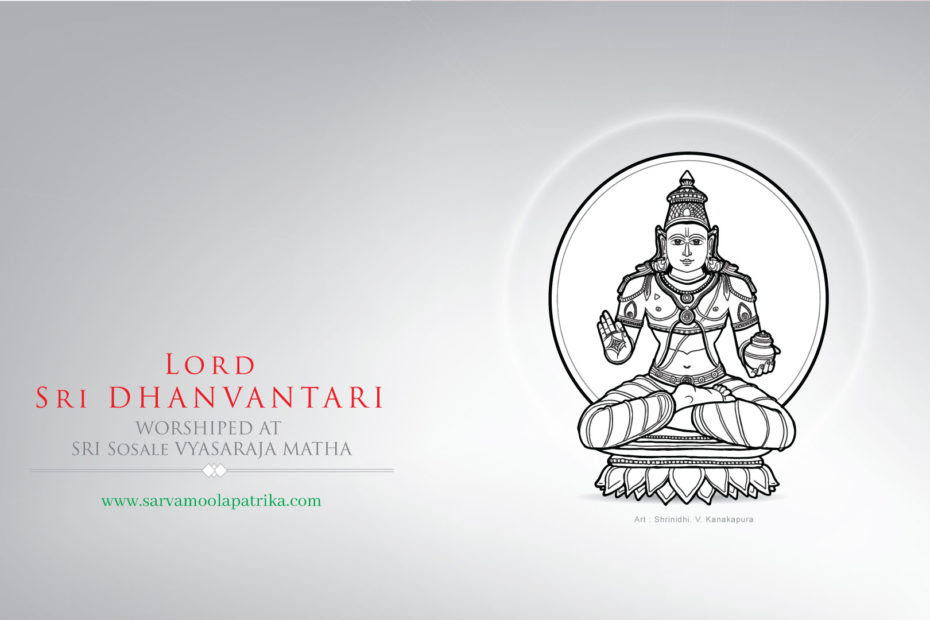- Author: Vidwan Sagri Raghavedra Upadhyaya
- Translator: Prabhanjana Kalya
- Illustration : Shrinidhi V. Kanakapura
ayaṁ mē hastō bhagavān ayaṁ mē bhagavattaraḥ |
ayaṁ mē viśvabhēṣajō̕yaṁ śivābhimarśanaḥ ||
This R̥gvēda hymn (10-60-12) has been incorrectly interpreted in the mādhavīyabhāṣya as ‘ayaṁ mē hastō bhagavān yasmāt sajīvaṁ subandhuṁ spr̥śati tasmāt’ – my palm is the God since it touches the living subandhu. The purport of this interpretation also seems to be directed towards an unknown subandhu.
However, śrīmadhvācārya, in his tantrasārasaṅgraha (4-115) says ayaṁ mē hasta iti ca mantraḥ pūrvōktavat smr̥taḥ- this hymn also is understood much like the hymn said above.
In this context, let us try to understand how this hymn unfolds as a panegyric to Lord Dhanvantari.
ayaṁ mē hastō bhagavān – My palm, which is utilized to count repeated recitation of various hymns (japa), the palm which is utilized for pious and spiritual activities such as ācamana, prāṇāyāma, aṅgan’yāsa, karan’yāsa, maṅgaḷārati, charity and other sacrificial activities, the palm whose presiding deity is none other than Lord Indra, such a palm, is resided by bhagavān, the bestower of good health and wellbeing – Lord Dhanvantari. As stated in brahmasūtra – na vakturātmōpadēśāditi cēdadhyātmasambandhabhūmā hyasmin (1-1-29), where Lord Indra who is specially possessed (entered) by bhagavān preaches to viśvāmitra by saying prāṇō̕hamasmi r̥ṣē prāṇastvaṁ …. “Everyone is bhagavān as He resides in all in the form of prāṇa.”
ayaṁ mē bhagavattaraḥ – Lord Dhanvantari, the one who has entered and especially in charge of my palm. (ayameva). As stated in Bhāgavata-tātparya-nirṇayaof Śrīmadhvācārya ’aiśvaryādiguṇaiḥ ṣaḍbhiḥ sāmagryāt sarvadēvatāḥ | bhagavacchabdavācyāśca…… ( Bha. Ta. Ni, 11-16-21) all the deities are addressed as bhagavān as they possess all qualities including the ownership of wealth. bhagavadbhyaḥ tarati vitarati amr̥tamiti bhagavattaraḥ – since Lord Dhanvantari distributes the nectar of immortality to all these deities, he is referred to as bhagavattaraḥ. bhagavataḥ tārayati sansārasāgarāditi bhagavattāraḥ, antarṇītaṇic bhagavattāra ēva bhagavattaraḥ – He is also addressed as bhagavattaraḥ as he helps them cross the ocean of worldly existence.
ayaṁ mē viśvabhēṣajaḥ – Lord Dhanvantari, the one who is imminent in the palm of my hand (ayameva), has all the medicines to cure any illness and worldly disease (viśvāni bhēṣajāni yasmin saḥ viśvabhēṣajaḥ.)
ayaṁ śivābhimarśanaḥ – Lord Dhanvantari is the one who brings us in contact with auspiciousness and bliss by:
• mūrdhni sthitādamuta ēva sudhāṁ sravantīṁ……..(Taṁ.Sā.Saṁ-4-96); residing in the six spiritual centers like sahasrāra etc. and pouring the nectar of immortality within us.
• ajñānaduḥkhabhayarōgamahāviṣāṇi yōgō̕yamāśu vinihanti sukhaṁ ca dadyāt (Taṁ.Sā.Saṁ-4-97); removing the ignorance, grief, fear, disease, insanity and mental confusions.
Hymn of Lord upēndra who resides in Indra – According the Vedic sūtra ’saptasu prathamā’, when the nominative case word hastaḥ (palm) in ayaṁ mē hastaḥ is taken as the seventh locative word hastē (in the palm) and ‘yasmāt tasmāt’ included in the mādhavīyabhāṣya , is interpreted thus :
yasmāt – because of which, ayaṁ mē hastaḥ – in this palm of mine (asmin mē hastē), bhagavān – the Lord of svarga loka , dēvēndra is present, and upēndra is in him as his controller, tasmāt – therefore, ayaṁ mē – this body of mine (ayaṁ can be inferred as body), bhagavattaraḥ – is the residence of Lord Hari. nirapēkṣaṁ tu sāmagryaṁ tasya sarvādhikaṁ yataḥ’ (bhā.Tā.Ni-11-16-21) – Lord vāsudēva who is absolute, superior to all, possessing the six qualities and primarily known as bhagavān, bestower of mōkṣa (liberation) is the facilitator. As in ‘abhāvādantarā̕n’yasya tvihaikārthau taraptamau’ (gī.Tā.-7-7), bhagavattaraḥ means bhagavattamaḥ.
Likewise, saṅkarṣaṇa known as bhēṣaja, specially resides in the body as bhagavān and provides a sanctuary from all fears. Similarly, anirud’dha, known as śivābhimarśana for bringing lives into contact with śiva i.e., bliss and auspiciousness, is the controller of sustenance is present in the body.
Further, the pradyumna form of Lord viSNu responsible for creation of the wealth called bhaga (universe) resides in the body as bhagavān. Such interpretation of this hymn facilitates cogitation upon upēndra and the caturmūrti forms. Through the inspiration and benevolence of the presiding deity of the hasta (palm) dēvēndra and his controller upēndra – spiritual and religious practices such as japa, worship, charity utilizing the palm can be performed and thereby receive the grace of the specially present vāsudēva, saṅkarṣaṇa, anirud’dha and pradyumna.
Dhanvantari in my possession: Ayaṁ mē hastō bhagavān – taking the seventh locative of the nominative hastaḥ, the meaning that arises is, the presence of bhagavān Dhanvantari in my possession, having earned his grace through devotion [prasādabhāktvaṁ samprōktaṁ prāṇaviṣṇōrjayastviti’ prabhan̄jana-(bhā,tā.Ni-11-14-35)] as conveyed in the ensuing three stanzas, leads to vāsudēva, saṅkarṣaṇa, anirud’dha and pradyumna gracing our body or palm with their presence.
Cogitating upon Dhanvantari: Dhanvantri resides in the body and the presiding deity of the palm dēvēndra and his controller upēndrā, grace us through the forms of vāsudēva, saṅkarṣaṇa, anirud’dha and pradyumna that are non-different. Such contemplation will make this hymn a mahāmantra. As stated by śrīmadhvācārya, ’dhyātvaiva hastatalagaṁ……….’ (tantrasārasaṅgraha- 4-98), the palms dripping with ambrosia, placed upon the head with the contemplation as elucidated above and repeating the hymn would rid one of all illness and sins.
